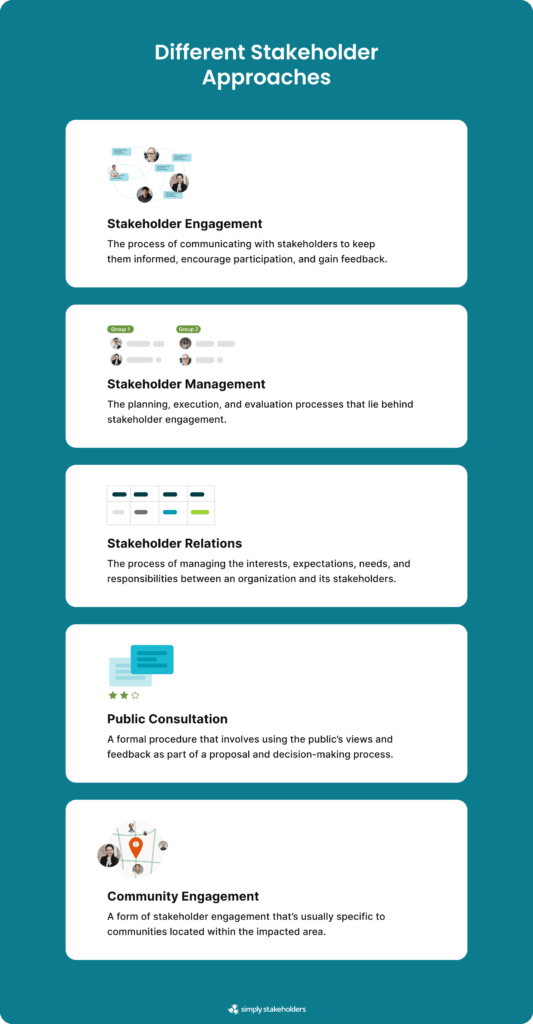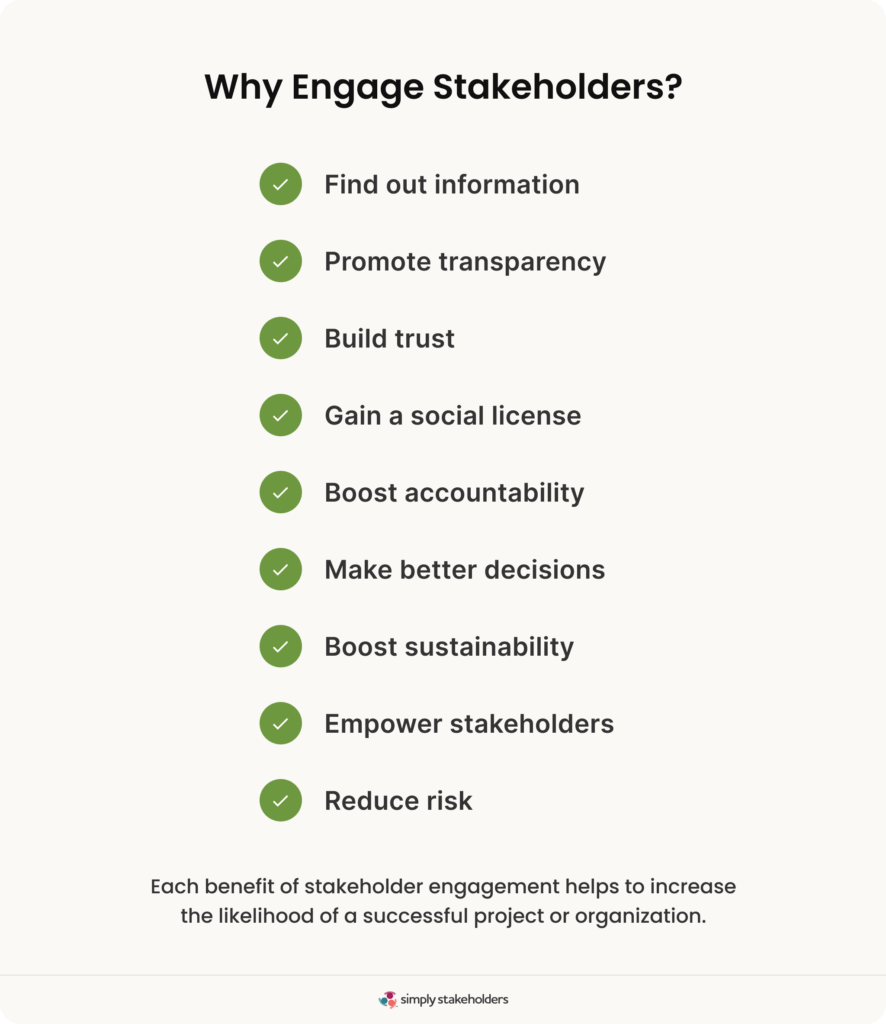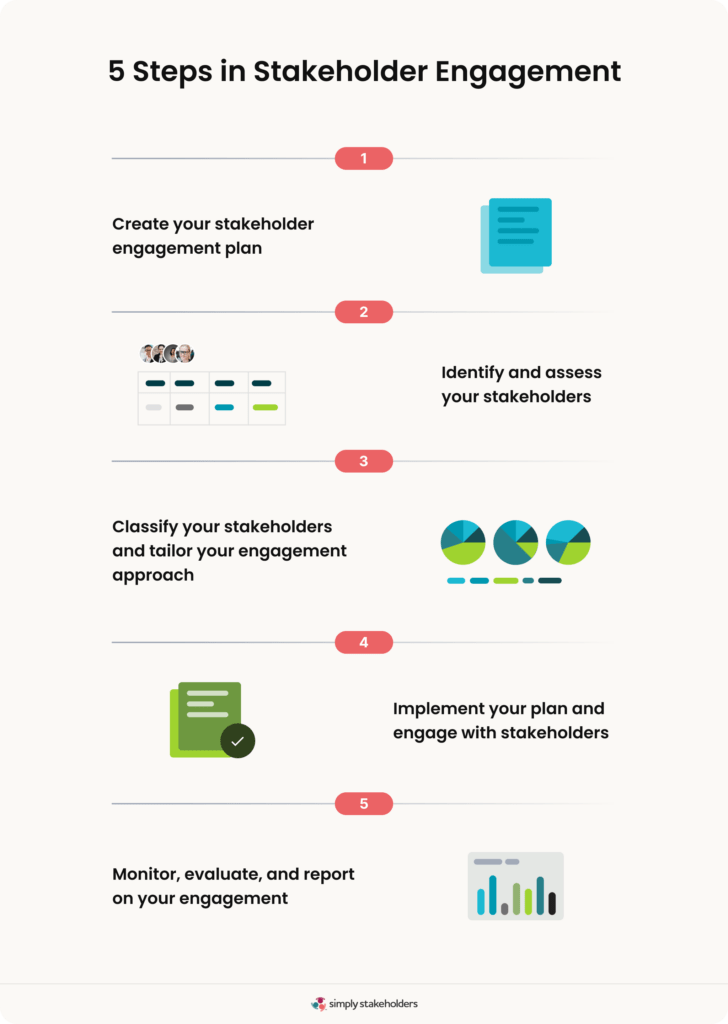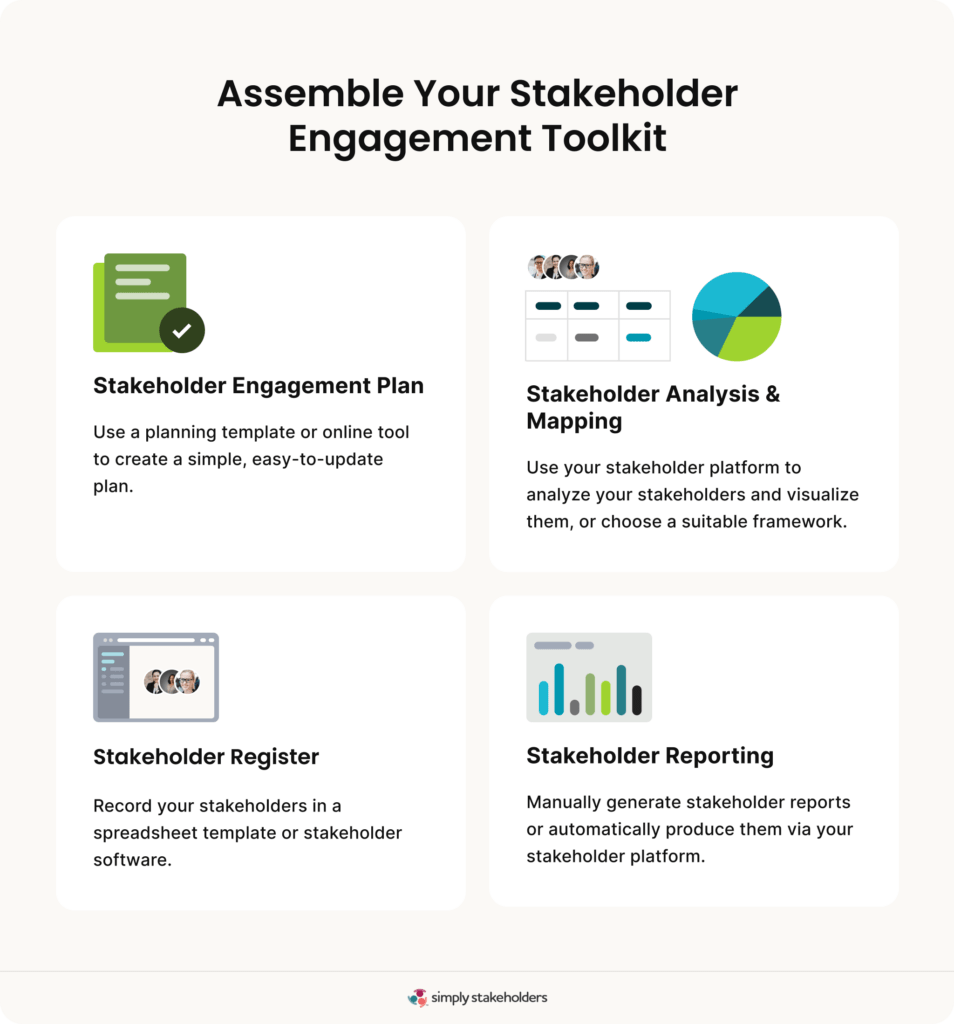Stakeholder Engagement: What It Means & Why It Matters

Curious about stakeholder engagement, what it really means, why it matters, and how you can get started with it?
Most professionals can benefit from at least a basic understanding of stakeholder engagement — but especially those involved in project management, leadership positions, the public sector, policymaking, sustainability initiatives, and projects with environmental or social impacts.
In fact, if the work you do is likely to impact other people, groups or organizations, or be influenced by them, you’ll likely need to do at least some level of stakeholder engagement. But what is stakeholder engagement and what’s involved? It’s all inside this guide…
What is Stakeholder Engagement?
Stakeholder engagement refers to the process of engaging with stakeholders. This can include identification, analysis, planning, communication, relationship building, participation, feedback, and reporting.
The main idea behind stakeholder engagement is to share information, gain insights, and increase support — leading to better decisions and better project outcomes that benefit organizations and their stakeholders.
Learn more about what a stakeholder means here.
What Isn’t Stakeholder Engagement?

A common misconception is that stakeholder engagement is the same as stakeholder management, stakeholder relations, public consultation, and community engagement. While these terms and associated processes may share some similarities, they do not mean the same thing.
To sum up the differences:
- Stakeholder management typically refers to the planning, execution, and evaluation processes that often lie behind stakeholder engagement.
- Stakeholder relations refers to the process of managing the interests, expectations, needs, and responsibilities between the organization and its stakeholders.
- Public consultation is a formal procedure that involves using the public’s views and feedback as part of a proposal and decision-making process.
- Community engagement is a form of stakeholder engagement specific to communities — and typically involves engaging those located in the area impacted by the project.
Why Does Stakeholder Engagement Matter?

To put it simply: stakeholder engagement matters because your stakeholders matter — and their knowledge, participation, and support can make all the difference when it comes to the success of your project or organization.
But let’s get a little more specific. Here are some benefits of engaging with stakeholders:
- Find out information – You’ll be surprised at what you didn’t know before you started surveying or talking to stakeholders
- Promote transparency – By sharing information with stakeholders (especially how your decisions are made) and regular updates on your activities, you’ll demonstrate your transparency (and hopefully encourage stakeholders to reciprocate)
- Build trust – Showing up consistently, communicating with stakeholders, and sharing openly will encourage stakeholders to trust you and your organization
- Gain a social license – Building trust and relationships with stakeholders, and allowing them to have an impact on your project can help you earn a social license to operate
- Boost accountability – By getting stakeholder involved and keeping them informed, you can help keep you project and organization on track to deliver what you promised
- Make better decisions – Stakeholder engagement will help to shine the light on information or factors you were previously unaware of, so that you can make better decisions based on a more complete picture
- Boost sustainability – Through your engagement process, you can learn about the different social, economic, and environmental factors that may be impacted by your project, and how you can operate in a more sustainable way for communities and other stakeholders
- Empower stakeholders – One of the cool things about deliberately engaging stakeholders is that you can hand back some power to the people who are impacted by your project (especially marginalized/forgotten groups) and allow them to have a voice
- Reduce risk – Engagement can help you discover risks you were unaware of so you can avoid or mitigate them, and by engaging with some stakeholders, you can actively manage issues or concerns that may lead to delays or problems
From these benefits, it’s easy to see how stakeholder engagement can lead to more successful projects — and conversely, how ignoring your stakeholders might lead to poor outcomes or even total failure.
The Stakeholder Engagement Process: 5 Steps

We’ve identified five main steps or milestones in the stakeholder engagement process, from planning to evaluation.
1: Create a Stakeholder Engagement Plan
The first step is to get strategic and determine your stakeholder engagement objectives. If you know what you want to achieve, this will help to shape your strategy, plan, and what you choose to evaluate later on. Note that steps 2 and 3 also form part of your stakeholder planning process — some initial stakeholder identification, analysis, and classification will help to determine your engagement approach.
We’re a big fan of keeping plans simple — you may only need one page to outline your engagement. Learn more about stakeholder engagement plans or check out our quick start guide.
2: Identify & Assess Stakeholders
Stakeholder assessment includes stakeholder identification, stakeholder analysis, and then stakeholder mapping, so that you can begin developing your understanding of stakeholders. So, start by creating your list of stakeholders — the people, groups, and organizations that may be impacted by, have an influence on, or an interest in your work. Then note down relevant characteristics and attributes that may be relevant to your engagement.
3: Classify Stakeholders
Stakeholder classification involves assigning a category or type to stakeholders based on what you discovered through analysis and mapping. From there, you can segment them into groups, plan your stakeholder engagement activities, and tailor your approach to each group.
You might determine that some stakeholders are primary stakeholders, others are secondary stakeholders, and out of those two groups, some are key stakeholders. Typically, your key stakeholders require engagement earlier on and more frequently because they’re more likely to influence the project outcomes or other stakeholders.
4: Engage with Stakeholders
Now it’s time to implement your plan. This will look different, depending on your resources, strategy, stakeholder groups, and what you outlined in your plan. But most of the time, it involves communicating with stakeholders, hosting events, gathering feedback, and encouraging input from stakeholders.
5: Monitor, Evaluate & Report
Throughout the stakeholder engagement process, it’s important to monitor your stakeholders to understand how they are responding to your engagement approach and the project itself. Evaluate your engagement based on the objectives you identified in step 1 — and adjust your approach based on stakeholder responses and feedback. Finally, you’ll likely need to report on your stakeholder engagement to both internal stakeholders and the people you’ve engaged with to demonstrate how their feedback has influenced the project.
Quick Tips for Engaging Stakeholders

Aside from following the right process for engaging with stakeholders, we have a few extra tips that’ll help you be more successful.
Follow Best Practices
Some examples of best practices include tailoring your communication and message to stakeholders, making your engagement inclusive so that all groups can participate, listening to stakeholders and acknowledging their feedback, and genuinely allowing stakeholder feedback to shape your decisions and project.
Track Your Engagement
You should be tracking your engagement from the beginning. This means adding your stakeholders to a stakeholder register (spreadsheet or stakeholder software), tracking any interactions with stakeholders, and recording any feedback. Tracking is important for collaboration, insights, reporting, evaluation, compliance, audits, and more.
Learn About the Principles
You may have already heard about the stakeholder engagement principles, such as the International Finance Corporation (IFC) Stakeholder Consultation Principles, the International Association for Public Participation (IAP2) Core Values, and the Association of Project Management (APM) Principles. Each of these offer useful guidance for running a responsible, best practice stakeholder engagement, so it’s worth getting familiar with them.
Offer Genuine Engagement
Some organizations approach stakeholder engagement like it’s purely for show. They want to tick the boxes, make it look like they care, and hope that their stakeholders stay out of the way. But that isn’t what stakeholder engagement is for, at all. You should be offering stakeholders a genuine opportunity to learn about the project with the purpose of getting their input in a way that can influence outcomes.
Continually Evaluate and Improve
You should always seek to improve your stakeholder engagement process and outcomes. Continually evaluate your engagement, review your analytics, ask for stakeholder feedback, and then incorporate that engagement. This will help you keep your engagement relevant and keep your stakeholder engaged long-term — perhaps even in your future projects!
Looking for more? Check out our previous content on stakeholder engagement tips: the dos and don’ts!
Stakeholder Engagement Tools

Whether you need to engage just a handful of stakeholders, or a list of thousands, you’ll likely need to acquire a few tools to support the process and help you engage as effectively and efficiently as possible. If you’re assembling your toolkit, here’s what we’d recommend including:
Stakeholder Engagement Plan
You’ll find plenty of stakeholder engagement plan templates online, or you could make your own based on our stakeholder engagement planning guide. We also offer an online stakeholder planning tool that’ll help you quickly generate a plan. Whatever you choose, make sure it’s easy to read, easy to keep updated, and something you’ll actually use.
Stakeholder Register
Another important tool is the stakeholder register. This is where you’ll store your stakeholder list, contact information, and any other info about your stakeholders. For a super basic stakeholder register, you might set up a spreadsheet, but for more features (including analytics, mapping, reporting, and tracking), we recommend looking for stakeholder software. Fortunately, even if you start with a spreadsheet, you can easily import it into most stakeholder platforms later on.
Stakeholder Analysis & Mapping Tools
There are so many ways to analyze and map stakeholders — though some methods are certainly more practical than others. Ideally, your stakeholder engagement platform will have stakeholder analysis and mapping built into the product, making it easy to update your analyses and generate visualizations. But if you need to manually analyze and map your stakeholders, check out these stakeholder diagrams to see some of the frameworks you could use.
Stakeholder Reporting Tools
Finally, you’ll need a way to evaluate and report on your stakeholder engagement. One tool you might come across is the stakeholder engagement assessment matrix, but once again, it’ll be more ideal if you can use the analysis and reporting tools already built into your stakeholder software.
The best kind of tool is one that does everything you need — ideally, all in one place. That way, you have a single source of truth for your stakeholder engagement, your data, and your team. Learn more about stakeholder engagement tools (what to look for and top tools on the market) or reach out to our team if you’d like a demo of our very own Simply Stakeholders product.



































